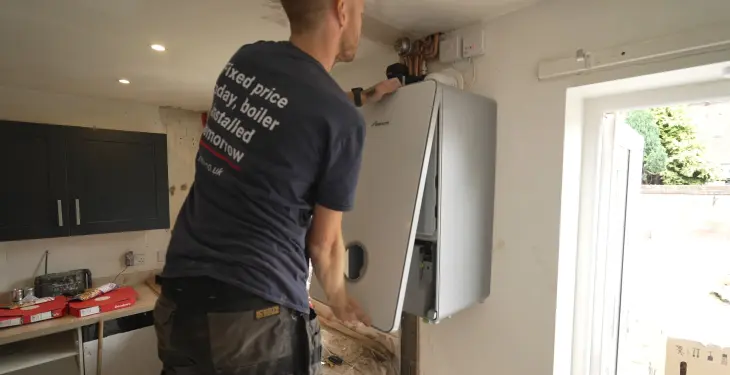

Written by Stephen Day
Gas Safe Engineer
Updated: 30th May, 2025
Repressurising a Baxi boiler means restoring the correct water pressure inside the boiler system. Boilers need a certain amount of pressure to function properly.
Get a new boiler quote, save up to £550 per year (0% APR available).
Repressurising a Baxi boiler means restoring the correct water pressure inside the boiler system. Boilers need a certain amount of pressure to function properly.
Repressurising a Baxi boiler is an essential skill for any homeowner. Low pressure in your boiler can lead to inefficient heating and hot water problems. Fortunately, adjusting the pressure in a Baxi boiler is a task you can easily manage on your own with a little guidance.
Ensuring that your boiler maintains the correct pressure level, typically between 1 to 1.5 bar, is crucial for its performance. Low boiler pressure can result from various factors like a leak or simply the system losing water over time. Recognizing and resolving this issue promptly can save you from unnecessary stress and costly repairs.
In this concise guide, we will walk you through the steps to repressurise your Baxi boiler. With simple instructions and tips, you'll be able to have your heating system running smoothly again in no time. Read on to learn how to do it safely and effectively.
Boiler pressure refers to the amount of water pressure inside a boiler system. It is crucial for the proper functioning of the boiler.
Most modern boilers, such as Baxi models, have a pressure gauge showing the current pressure.
The pressure typically should be between 1 and 1.5 bar. A pressure reading in this range ensures the boiler operates efficiently and safely.
Too low or too high pressure can lead to problems:
Low Pressure (< 1 bar): Can cause the boiler to shut down.
High Pressure (> 2 bar): May cause leaks or damage.
Regularly check the pressure gauge on your boiler. It helps you catch issues early.
To adjust the pressure:
Increase Pressure: Open the filling loop or use the filling key, allowing water to enter until the pressure reaches the optimal range.
Decrease Pressure: Bleed radiators to release excess water and lower the pressure. Bleeding should be done before checking and adjusting the pressure.
Proper pressure is vital for heating efficiency. It ensures the boiler provides consistent hot water and heating while preventing system malfunctions.
Having the correct boiler pressure helps you avoid costly repairs and maintain a comfortable living environment.
Repressurising a Baxi boiler means restoring the correct water pressure inside the boiler system. Boilers need a certain amount of pressure to function properly.
Pressure is often measured in bars, with the ideal range being between 1 and 1.5 bars.
When the pressure drops below this range, it can affect the boiler's efficiency and performance. A common reason for a drop in pressure is a leak or air trapped in the system.
To repressurise the boiler, you'll often use a filling loop. This is a crucial part of the boiler's system and can be either internal or external.
Internal filling loop: Built into the boiler and typically involves using a key.
External filling loop: A separate hose that connects the boiler to the mains water supply.
Check the pressure gauge: Locate the dial to see if the pressure is below 1 bar.
Use the filling loop:
Attach the loop if it's external.
Open the valves (there could be one or two, depending on the model).
Monitor the pressure: Keep an eye on the gauge as you open the valves slowly.
Close the valves: Once the pressure reaches the desired level, close the valves to stop the water flow.
Disconnect the filling loop: If your filling loop is external, ensure you disconnect it after repressurizing to prevent backflow.
Repressurising ensures the boiler operates efficiently and maintains a comfortable temperature in your home. It's a straightforward task that most people can do themselves without needing a heating engineer.
The ideal pressure for a Baxi boiler is typically between 1.0 and 1.5 bar. Boiler pressure gauges are used to check this measurement.
When the system is cold, the pressure should read around 1.0 bar.
For most Baxi boilers, a pressure between 1.0 and 1.5 bar is ideal. During normal operation, the pressure may rise slightly when the system heats up. This is normal and expected.
If the pressure falls below 1.0 bar, the boiler might struggle to heat your home efficiently. This usually indicates that the system needs to be repressurised.
Low Pressure: If the gauge shows less than 1.0 bar, the boiler may not function properly.
High Pressure: If the pressure exceeds 2.0 bar, it could cause damage to the system.
Monitoring the pressure gauge regularly will help in catching any issues early. Checking once a month is a good practice. If the readings are constantly incorrect, there may be a leak or another issue within the system that needs attention.
Correct boiler pressure ensures that your heating system works efficiently and safely. Knowing how to read and interpret the boiler pressure gauge helps in maintaining optimal performance.
Low boiler pressure in a Baxi boiler can be caused by several factors.
Leaks: Leaks in the central heating system are a common cause. Even small leaks can lead to significant drops in pressure over time. Check radiators, pipes, and connections for any signs of water escaping.
Faulty Pressure Relief Valve: This valve releases excess pressure. If it's faulty or stuck open, it can cause low water pressure.
Expansion Vessel: The expansion vessel maintains pressure in the boiler. If it loses air, it can cause pressure drops. Sometimes, it needs recharging.
Air in the System: Air in the radiator or pipes can lead to low boiler pressure. Bleeding the radiator can help release trapped air.
Below is a table showing common causes:
Cause | Description |
|---|---|
Leaks in system | Small leaks in pipes or radiators can lower pressure. |
Faulty pressure relief valve | If stuck open, it releases pressure continuously. |
Expansion vessel issues | Loss of air in the vessel leads to pressure drops. |
Trapped air | Air pockets in the system can cause pressure issues. |
Experiencing low boiler pressure often results in no heating or hot water, making it important to identify the cause quickly.
Regular checks and maintenance can help prevent these issues.
A Baxi boiler that's losing pressure can cause big problems. Knowing how to spot the signs early is important. Here are some simple ways to check for low pressure:
First, look at the pressure gauge. This is usually found on the front of the boiler. The needle should be in the green zone, which means it's at the right pressure. If the needle is in the red or below 1 bar, the pressure is too low.
Another thing to check: Are radiators not getting hot? This might be a clue. Low pressure can stop the boiler from heating properly. If rooms feel colder than usual, it's worth a look at the gauge.
Check the cold water supply next. Low pressure can sometimes be caused by issues with the cold water coming in. Make sure the valves are open and there are no leaks.
Look for error codes on the boiler display. Some Baxi boilers will show an error code if the pressure is too low. Common codes include E119. These codes can help pinpoint the problem quickly.
Finally, listen for any strange noises. Hissing or gurgling sounds can hint at low pressure or air in the system. These noises mean you should check the pressure gauge right away.
Keep an eye out for these signs to catch low pressure before it turns into a bigger issue.
Yes, you can repressurise your Baxi boiler yourself.
Most Baxi boilers are fitted with a pressure gauge, usually a small dial. Check if the pressure is below 1 bar. If so, it needs to be topped up.
A filling loop
Flathead screwdriver (if required)
Towel or cloth to catch water drips
Check the Pressure: Locate the pressure gauge. If it reads below 1 bar, you need to repressurise.
Bleed the Radiators: Before repressurising, it’s useful to check for trapped air in the radiators. Bleed the radiators to release air. This can affect the boiler’s pressure.
Locate the Filling Loop: This is usually found beneath your boiler. It could be an Easy-fill link or a Rigid filling link.
Insert the Key or Hose: Insert the filling key or attach the hose, depending on your model. Turn slowly.
Adjust the Pressure: Watch the pressure gauge as you fill. Aim for 1 to 1.5 bars.
Finish Up: Remove the key or hose, wipe any spills with the towel or cloth, and disconnect the filling loop if it’s external.
Important: If you need to repressurise frequently, it might indicate an underlying issue, like a leak or a problem with the pressure relief valve.
If you prefer not to do this yourself, or if you encounter any issues, you can call a heating engineer for assistance.
It's important to know when to call a Gas Safe Registered Engineer. Not all issues can be fixed by yourself, and some might even be dangerous to handle without a professional.
Leaks: If you notice water or gas leaks, stop using your boiler immediately. Leaks can be hazardous and need immediate attention from a qualified heating engineer.
High Pressure: Consistently high boiler pressure may point to a more serious problem. A professional can diagnose and fix high boiler pressure, ensuring your system runs safely.
Lack of Heat: If your boiler stops heating water or your home, despite showing the right pressure, it’s time to call in an expert. They can identify and repair any underlying issues.
Regular Maintenance: Boilers need periodic maintenance for safety and efficiency. A Gas Safe registered engineer can perform these checks, ensuring everything runs smoothly.
Boiler Not Repressurising: If you’ve tried to repressurise your boiler but it’s not working, a professional can help. They have the skills and tools to pinpoint the issue and fix it promptly.
Regular checks and maintenance by a Gas Safe engineer can prevent breakdowns and extend the life of your boiler. Always prioritize safety by consulting a professional for any complex or potentially dangerous issues.
Repressurising a Baxi boiler is often a simple task that can be done by homeowners. For those who choose to do it themselves, the cost is usually £0, as it typically requires no special tools or materials.
Call-out Fees: Some heating engineers may charge a call-out fee, typically ranging from £50 to £100.
Labour Costs: If the task takes longer or involves more than just repressurising, labour costs can add up. This can be around £30 to £60 per hour.
Additional Repairs: If other issues are found during repressurising, such as leaks or faulty parts, additional costs may apply. These can range from £20 to £200, depending on the severity.
Combining repressurising with a regular boiler service can be cost-effective. A standard boiler service usually costs between £70 and £100. If repressurising is done during this routine check, there may be no extra charge.
In summary:
Item | Estimated Cost |
|---|---|
DIY Repressurising | £0 |
Professional Call-out | £50 - £100 |
Labour Costs | £30 - £60 per hour |
Boiler Servicing | £70 - £100 |
Additional Repairs | £20 - £200 |
Regular maintenance work and timely boiler servicing can help avoid pressure issues and reduce the need for frequent repressurising.
New boilers can be a daunting purchase for many people as they’re an appliance with a lot of responsibility, providing heat for you and your family is something you want to get right. Boilers aren’t exactly a quickly disposable item either, potentially lasting you a decade.
Effectively, new boiler cost can be split into two segments: the first is the actual boiler itself (unit price), and the second is the cost of the boiler being installed (set up) in your property by an expert engineer.
Here at iHeat, we remove all of this undue stress and make the decision making process of upgrading to a new heating system, as easy as possible.
New boiler costs can vary depending on a number of factors including their brand, model, fuel, output, warranty, labour and boiler installation type. Typically a new boiler will cost between £1,845 and £3,500, below is a list of average boiler installations offered by iHeat (guide only).
Installation Type | Price (inc VAT) | |
Combi to combi swap | £1,845 | |
System to combi conversion | £2,499 | |
New boiler install | £2,899 | |
Back boiler to a combi | £3,299 | |
System to system | £1,945 |
Last updated: 30th May, 2025

Written by Stephen Day
Gas Safe Engineer at iHeat
Stephen Day is a Gas Safe registered and FGAS certified engineer with over 20 years of hands-on experience in the heating, cooling, and renewable energy industry, specialising in boiler installations, air conditioning, and heat pump systems.
LinkedInArticles by Stephen Day are reviewed by iHeat’s technical team to ensure accuracy and reliability.

22nd December, 2025
Based on data from over 7000 boiler installations completed by iHeat in the past 12 months...
 Read Article
Read Article

22nd December, 2025
Here’s a quick roundup of the best combi boilers for 2026.
 Read Article
Read Article

22nd December, 2025
When your old boiler breaks down and it comes time to replace it with a new one, it might...
 Read Article
Read Article
No obligation. Takes less than 60 seconds.